Whatever new normal emerges from the pandemic, COVID-19 has sharpened employers’ focus on employee health and wellbeing.
For sponsors of workplace retirement plans, that means directing more attention to how employees will shoulder the cost of healthcare in retirement. Nearly nine in 10 plan administrators say rising medical costs threaten to set back savers, according to TIAA’s latest annual plan sponsor survey.
Though more than half (54%) of employers have added health savings accounts to their retirement plans in an effort to help employees gain ground, 38% of plan sponsors say they would like an assist in persuading people to use them.

Author Richard Ward
The request reflects the reality that neither savings nor the safety net has kept pace. The share of income replaced by Social Security is falling at the same time the cost of Medicare is rising. The average couple could need an estimated $325,000 to cover the out-of-pocket cost of healthcare in their golden years, according to data from the Employee Benefit Research Institute. That includes premiums for Medicare Parts B and D, outlays for essentials such as dental care and hearing aids, as well as the cost of care at the end of their lives. It also includes the cost of premiums for a Medigap Plan G.
While few retirees have any idea what their health expenses will be, administrators can leverage many of the lessons they’ve learned from work to boost participation in 403(b) accounts to encourage the use of HSAs.
Those lessons, which draw on both the design of retirement plans and technology, offer insights into helping workers see saving for healthcare as a subset of building lifetime financial security.
Here’s a look at three ways to encourage HSAs.
Make health savings part of your ecosystem of support. The first insight for plan sponsors lies in integrating HSAs within their workplace savings plans as part of an ecosystem for achieving retirement security. That means syncing health savings with the goal of a successful retirement.
Technology can help. Some HSAs, like TIAA’s, provide participants with an easy-to-use visual interface that gives a holistic view of employees’ savings across their workplace accounts (retirement, HSA, insurance, etc.). Tools can give employees the ability to further manage their HSA account profiles, review/pay claims and access tax documents.
To help grow HSA account values to help meet future healthcare expenses, employees have access to a diversified menu of low-cost mutual funds. Employees can self-select their asset allocations or let the technology tailor investments automatically based on their risk profile and goals. Guides and step-by-step tutorials allow employees to find information, explore scenarios and select investments.
Employers can leverage that personalization by tailoring reminders to employees based on their compensation, number of dependents, use of benefits, and progress toward achieving savings goals.
Make it easy. HSAs can be a challenge for employees who may be trying to differentiate among retirement savings accounts or simply figuring out how to get started. HSA selection and contribution amounts are affected by the type of health plan the employee has elected, whether an employee has dependents, or the time until the employee expects to enroll in Medicare.
Employers can simplify the choice by putting HSAs into context. Unlike contributions to 403(b) accounts, contributions to HSAs are not subject to federal payroll taxes. Nor are savers required to start taking cash out of HSAs at age 72. Savings in HSAs are never taxed if the money is used for qualified medical expenses. Non-medical distributions after age 65 are only taxable at ordinary income tax rates, which places them on par with retirement accounts.
However, any distributions prior to age 65 and not used for qualified medical expenses are subject to ordinary income tax and a 20% penalty tax.
Plan sponsors can help by using tools to make it easy for employees to better understand their savings options when thinking about their HSAs in the context of their retirement savings plan. The platform features a series of visualizations and other tools designed to help employees optimize their orientation toward retirement income goals.
Nudge creatively. Just as setting default options and auto-escalated savings rates boosts participation in 403(b) accounts, plan sponsors can configure their HSAs to steer employees toward a contribution strategy that works for their individual needs by offering what is referred to as a flexible match.
Though many employers match contributions to 403(b) accounts, through a seed rather than match contributions to HSAs, research suggests that an employer contribution (seed or match) leads to significantly higher participant contributions. Employer money forces employees to take notice, creating more awareness of the account and the benefits of making their own contributions.
HSAs offer workers a way to cover the cost of medical expenses in retirement. Now more than ever, employers have within reach the know-how to help HSA participants take the fullest advantage of them.